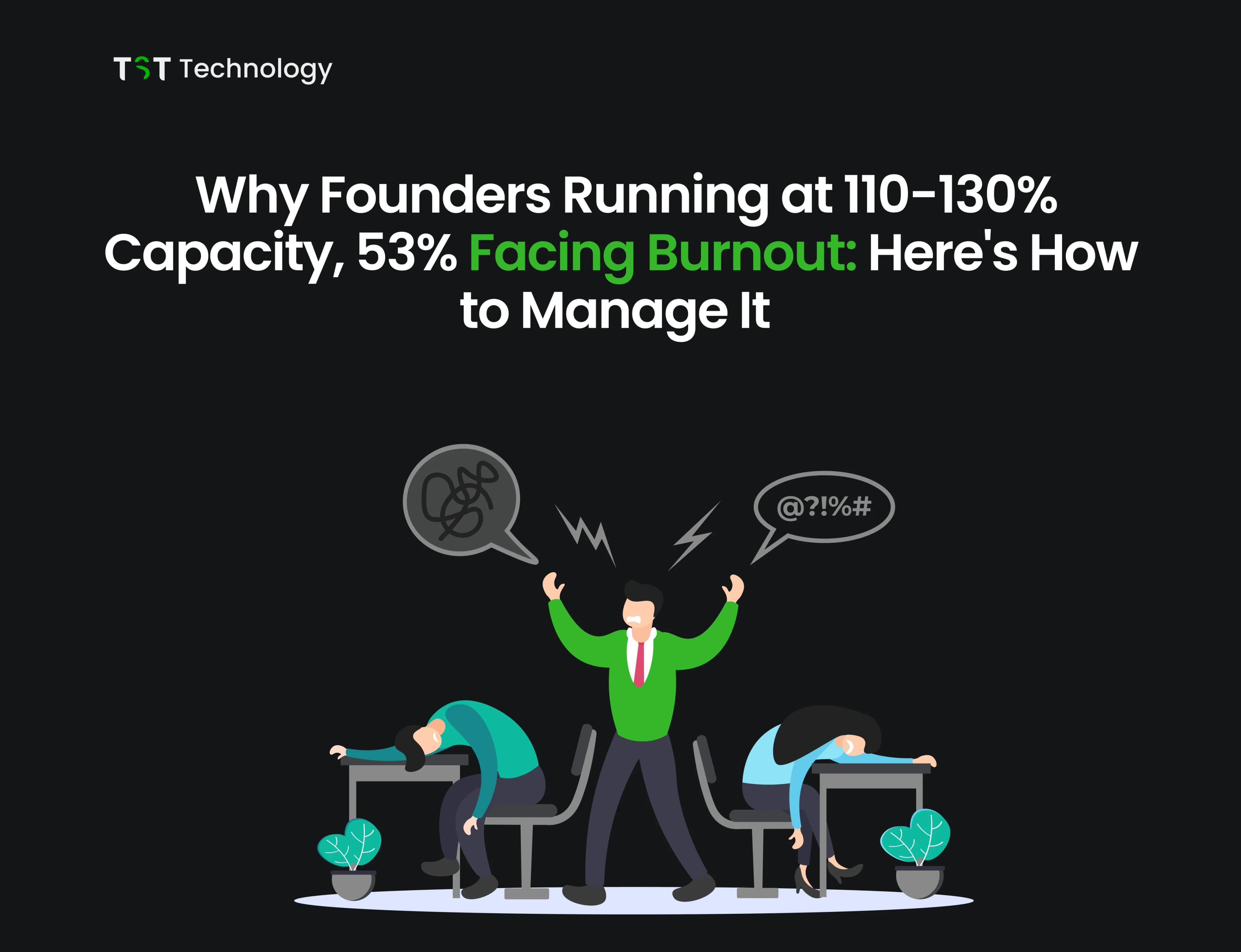Have you ever felt so exhausted at work that you couldn’t focus anymore?
You’re not alone.
According to a survey by Deloitte, 77% of employees have experienced burnout in their current jobs, and more than half have faced it multiple times.
Burnout is more common than we think, but many causes go unnoticed.
In this blog, we’ll look at some hidden reasons for workplace burnout and how they affect employees and businesses. Let’s find simple ways to solve this problem together!
What is Burnout?

Burnout is a state of mental, physical, and emotional exhaustion caused by long-term, unmanaged stress at work. It leads to feelings of being drained, unmotivated, and ineffective in one’s job. Common symptoms include exhaustion, detachment from work, and reduced productivity.
Burnout can also affect your physical health, causing problems like headaches, muscle pain, and trouble sleeping. It isn’t the same as regular stress; it builds up over time and deeply impacts both personal and professional life.
Why is Burnout a Growing Concern?
A survey found that 42% of workers globally felt burnt out in 2023, the highest level since 2021.
Burnout doesn’t just affect employees but it’s bad for businesses too. It lowers productivity, increases absences, and causes more employees to leave, which can be very costly.
Addressing burnout is essential for creating a healthy and productive work environment.
The Hidden Causes of Burnout You Can’t Ignore

Have you ever felt exhausted, like the work never stops? Burnout isn’t just about being tired - it’s a deeper issue caused by things we often overlook.
Let’s explore some hidden causes of burnout that could be affecting you.
1. Unmanageable Workload
- When employees have too much work or tight deadlines, they feel overwhelmed. Without enough time to rest, this pressure leads to mental and physical exhaustion.
2. Lack of Control
- Feeling powerless at work, like not having a say in decisions or how tasks are done, can make employees feel stuck. This lack of control can cause frustration and stress.
3. Unclear Job Roles
- When employees are unsure about their responsibilities, it creates confusion and anxiety. This uncertainty makes them feel ineffective and drains their energy.
4. No Recognition or Rewards
- When hard work is ignored or underappreciated, employees feel undervalued. Lack of rewards or praise kills motivation and increases feelings of burnout.
5. Poor Work-Life Balance
- When work takes over personal time, employees lose the chance to recharge. Constant work pressure leaves them exhausted and affects their mental well-being.
6. Toxic Work Environment
- Negative workplace politics, favouritism, or conflicts with colleagues create unnecessary stress. A toxic environment can make employees feel unsupported and drained.
7. Limited Support
- When employees don’t get enough help or encouragement from their managers or teammates, they feel isolated. This lack of support increases stress and burnout.
8. Mismatch in Values
- When an employee’s values don’t align with their company’s mission, they become dissatisfied, feel disconnected, and are unmotivated to work hard.
9. High Pressure to Perform
- Constantly meeting high expectations without a break drains employees. Over time, this continuous stress leads to emotional and physical exhaustion.
10. Personal Life Stress
- Problems outside of work, like financial struggles or family issues, add to work-related stress. When combined, these challenges make burnout more likely.
Burnout doesn’t happen overnight - it builds up from small, unnoticed problems like a lack of support or unclear roles.
By identifying these hidden causes, we can take steps to create a healthier work-life balance. Remember, your well-being matters, so don’t ignore the signs of burnout.
Stay mindful, and take care of yourself!
The Impact of Burnout on Businesses

Burnout is more than just feeling tired. It deeply affects an employee’s emotional and physical well-being, leading to reduced productivity and negative business outcomes.
Understanding the impact of burnout can help companies take necessary actions to prevent it and maintain a healthy workplace.
Key Points on the Impact of Burnout on Businesses:
1. Decreased Productivity
- Burned-out employees often struggle to concentrate and get distracted easily. This results in longer task completion times, more mistakes, and reduced output, affecting overall productivity in the company.
2. Increased Absence
- Employees experiencing burnout may take more sick days or even leave the company. This leads to more unplanned absences, disrupting work processes and putting extra strain on other team members.
3. Lower Quality of Work
- Burnout reduces focus and mental energy, leading to mistakes and lower-quality work. As a result, businesses face more errors, missed deadlines, and dissatisfied customers, which can harm the company’s reputation.
4. Higher Employee Turnover
- Employees who feel burned out are more likely to leave their jobs. This increases recruitment and training costs for businesses and can lead to a loss of valuable experience and knowledge.
5. Negative Work Environment
- A burnout culture creates a toxic work environment. Employees become disengaged and frustrated, which affects team morale and collaboration and can lower the workplace's overall energy.
6. Loss of Institutional Knowledge
- When experienced employees leave due to burnout, they take valuable knowledge and skills with them. This loss of expertise can hinder the company’s progress and make it harder to achieve long-term goals.
7. Increased Costs for the Company
- Burnout affects employee well-being and leads to financial costs. From higher absenteeism and turnover to decreased productivity and lost revenue, indirect costs can significantly impact a company’s bottom line.
By recognizing its impact and taking steps to address it, businesses can improve productivity, employee retention, and overall well-being.
Investing in employee well-being can ultimately save costs and lead to a healthier, more efficient workplace.
Real-Life Case Studies: Burnout in Action
1. Slack's Approach to Burnout

During the COVID-19 pandemic, Slack realized the importance of understanding employees' challenges, so they used surveys to gather feedback. This allowed them to adapt quickly and provide better support.
For example, Slack introduced "Fridays," where employees took the same Friday off each month to focus on relaxation and recharge.
Slack also identified employees struggling with caregiving or mental health through well-being surveys. This helped them offer more flexible schedules, allowing employees to work at their own pace and reduce stress.
- Slack’s surveys helped address employee concerns and provided personalized support.
- The "Fridays" initiative created a sense of community and work-life balance.
- Focused on flexibility, allowing employees to work during hours that suit them best.
2. Talkdesk's Focus on Employee Wellbeing

Talkdesk, a cloud contact centre, saw a shift in the employee experience when remote work became the norm. They recognized that some employees might feel uncomfortable discussing mental health or loneliness in public. To address this, they used surveys to listen actively to their employees' needs.
Survey results revealed that employees wanted more interaction and engagement, leading Talkdesk to introduce its first-ever Wellness Week. The company also expanded its Diversity and Inclusion programs to further support its workforce.
- Surveys helped Talkdesk identify key employee needs and concerns.
- Wellness Week provided a dedicated space for employees to focus on their health.
- Increased engagement opportunities helped employees feel more connected.
3. Equinix’s Focus on Supporting Managers

Equinix, a real estate investment trust company, launched an initiative called "Manager Cafes" to help managers better support their teams during the pandemic. These interactive sessions taught managers how to recognize burnout, reprioritize tasks, and reduce unnecessary workloads, focusing on what's most important to the team.
The sessions helped managers have more empathetic conversations with their employees and create a safer environment for discussing stress and burnout. This initiative was crucial in managing employee well-being while maintaining productivity.
- "Manager Cafes" helped managers learn to better support their teams.
- The sessions focused on how to reduce unnecessary workloads and prioritize tasks.
- Empathy-driven conversations made it easier for employees to talk about their struggles.
These real-life case studies show how companies like Slack, Talkdesk, and Equinix have proactively addressed burnout. By listening to their employees and offering flexible support, they’ve built healthier work environments that prioritize well-being, resulting in a more motivated and engaged workforce.
How to Prevent Burnout in Your Organization?

Burnout is a growing concern in workplaces today. It can impact employee well-being, reduce productivity, and harm the overall work environment. Preventing burnout requires a thoughtful approach that focuses on both individual needs and organizational practices.
Here are some actionable strategies to help your organization prevent burnout effectively.
- Promote employee well-being by creating a supportive and healthy environment.
- Encourage open communication to address stressors and challenges early on.
- Define job roles clearly to avoid confusion and reduce stress.
- Set boundaries to maintain a balance between work and personal life.
- Regularly monitor workloads to ensure tasks are manageable for employees.
- Allow employees time for breaks and recovery during work hours.
- Foster team bonding to create a sense of belonging and support.
- Give employees control over their tasks and schedules for autonomy.
- Recognize employee contributions regularly to boost morale and motivation.
- Support self-care habits like exercise, healthy eating, and proper sleep.
- Provide access to counselling or mental health resources for employees.
- Encourage employees to take vacations and use their leave days fully.
- Offer flexible work options to reduce stress and improve productivity.
- Train managers to handle employee stress and support work-life balance.
- Gather employee feedback to improve workplace practices and reduce burnout.
Preventing burnout requires a proactive and compassionate approach from both leadership and employees. By fostering a supportive culture, promoting well-being, and addressing stressors early, organizations can create an environment where employees thrive.
Together, these strategies can reduce burnout risks and ensure a healthier, more productive workplace.
Conclusion
Burnout is a critical issue that impacts both employees and organizations. It leads to reduced productivity, affects employee well-being, and contributes to higher turnover rates. Identifying the hidden causes of burnout is essential for businesses to take proactive steps to prevent it.
By addressing factors like excessive workload, management challenges, and poor work-life balance, companies can foster a healthier, more productive environment. If you're experiencing burnout, reach out to your manager or seek support, so that together, we can create a better workplace.
Take action today and create a burnout-free environment for your team. See you again soon!
























































